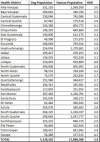Heterogeneity in dog population characteristics contributes to chronic under-vaccination against rabies in Guatemala
- PMID: 35797418
- PMCID: PMC9295952
- DOI: 10.1371/journal.pntd.0010522
Heterogeneity in dog population characteristics contributes to chronic under-vaccination against rabies in Guatemala
Abstract
Guatemala has held dog rabies mass vaccination campaigns countrywide since 1984, yet the virus remains endemic. To eliminate dog-mediated human rabies, dog vaccination coverage must reach at least 70%. The Guatemala rabies program uses a 5:1 human:dog ratio (HDR) to estimate the vaccination coverage; however, this method may not accurately reflect the heterogeneity of dog ownership practices in Guatemalan communities. We conducted 16 field-based dog population estimates in urban, semi-urban and rural areas of Guatemala to determine HDR and evaluate the standard 5:1. Our study-derived HDR estimates varied from 1.7-11.4:1 (average 4.0:1), being higher in densely populated sites and lowest in rural communities. The community-to-community heterogeneity observed in dog populations could explain the persistence of rabies in certain communities. To date, this is the most extensive dog-population evaluation conducted in Guatemala, and can be used to inform future rabies vaccination campaigns needed to meet the global 2030 rabies elimination targets.
Conflict of interest statement
The authors have declared that no competing interests exist.
Figures







References
-
- Vigilato MA ntoni N, Clavijo A, Knobl T, T Silva HM arcel., Cosivi O, Schneider MC ristin., et al.. Progress towards eliminating canine rabies: policies and perspectives from Latin America and the Caribbean. Philos Trans R Soc Lond B Biol Sci. 2013;368: 20120143. doi: 10.1098/rstb.2012.0143 - DOI - PMC - PubMed
Publication types
MeSH terms
Substances
LinkOut - more resources
Full Text Sources
Medical

